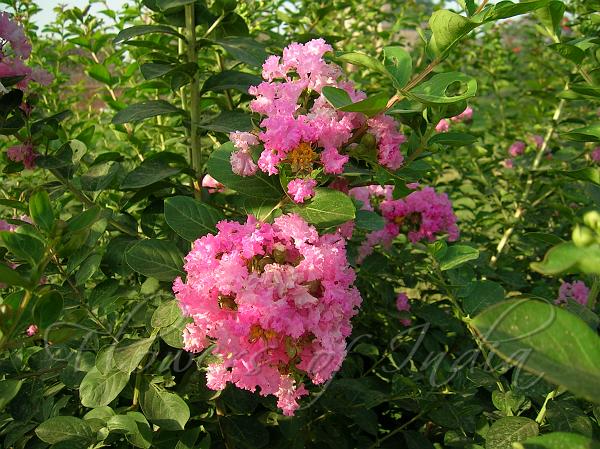|
| Common Crape Myrtle |
|

|

| File size | 689843 |
| Original date | 5/15/05 7:07 AM |
| Resolution | 2048 x 1536 |
| Flash | Flash did not fire, auto |
| Focal length | 5.4mm |
| Exposure time | 1/307s |
| Aperture | 2.8 |
| Focus Distance | |
| Metering Mode | Partial |
| Camera make | NIKON |
| Camera model | E3700 |
| Sensor type |
|
|
|
|
Photo: |
Botanical name: Lagerstroemia indica Family: Lythraceae (Crape Myrtle family)
Synonyms: Lagerstroemia indica var. alba, Lagerstroemia elegans, Lagerstroemia minor
Synonyms: Lagerstroemia indica var. alba, Lagerstroemia elegans, Lagerstroemia minor
Crape myrtle is the smaller cousin of
Queen Crape Myrtle. It is an
often multi-stemmed, deciduous tree with a wide spreading, flat topped,
rounded, or even spike shaped open habit. Planted in full sun or under
canopy, the tree is a popular nesting shrub for songbirds and wrens.
The bark is a prominent feature being smooth, pinkish-gray and mottled,
shedding each year. In colder areas, the leaves also shed each winter,
after spectacular color display, and bare branches re-leaf early in the
spring; leaves are small, smooth-edged, circular or oval-shaped, and
dark green changing to yellow and orange and red in autumn. Flowers, on
different trees, are white, pink, mauve, purple or carmine with crimped
petals, in panicles up to 9 cm. Capsules are ellipsoidal, 1-1.3 ×
0.7-1.2 cm, 4-6-valved. Seeds including wing about 8 mm. Common Crape
Myrtle is found in the Himalayas amd Indo-China, China, at altitudes of
1000-1500 m. It is also widely cultivated. Flowering: June-September.
Medicinal uses: Bark, leaves and flowers are
considered hydragogue and drastic purgative. Bark is also considered
stimulant and febrifuge. Roots are astringent and used as gargle. Seeds
have narcotic properties. In Manipur, flowers and leaves are used as
purgatives. Bark is stimulant and febrifuge (fever removing) Roots are
astringent and used as gargle.
Bark, leaves and flowers are
considered hydragogue and drastic purgative. Bark is also considered
stimulant and febrifuge. Roots are astringent and used as gargle. Seeds
have narcotic properties. In Manipur, flowers and leaves are used as
purgatives. Bark is stimulant and febrifuge (fever removing) Roots are
astringent and used as gargle.
Medicinal uses:
 Bark, leaves and flowers are
considered hydragogue and drastic purgative. Bark is also considered
stimulant and febrifuge. Roots are astringent and used as gargle. Seeds
have narcotic properties. In Manipur, flowers and leaves are used as
purgatives. Bark is stimulant and febrifuge (fever removing) Roots are
astringent and used as gargle.
Bark, leaves and flowers are
considered hydragogue and drastic purgative. Bark is also considered
stimulant and febrifuge. Roots are astringent and used as gargle. Seeds
have narcotic properties. In Manipur, flowers and leaves are used as
purgatives. Bark is stimulant and febrifuge (fever removing) Roots are
astringent and used as gargle. | Identification credit: Radhika Vathsan | Photographed in Delhi. |
• Is this flower misidentified? If yes,